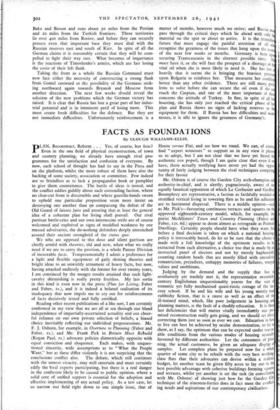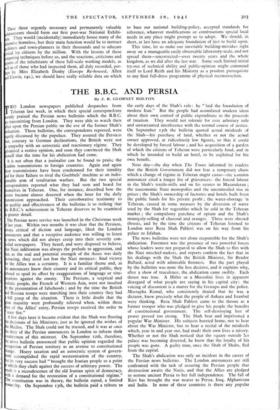FACTS AS FOUNDATIONS
By CLOUGH WILLIAMS-ELLIS.
PLAN, Reconstruct, Reform . . . Yes, of course, but how? Even in the one field of physical reconstruction, of town and country planning, we already have enough rival pro- grammes for the satisfaction and confusion of everyone. By now, each school of thought has had its say in the Press and on the platform, whilst the more robust of them have also the backing of some society, association or committee. Few indeed are so friendless as to lack a propagandist book or pamphlet to give them countenance. The battle of ideas is joined, and the conflict eddies giddily about each contending faction, where no clear-cut front is discernible and where guerilla-bands sworn to uphold one particular proposition seem more intent on destroying one another than on compassing the defeat of the Old Guard of laissez faire and assuring that at least the general idea of a coherent plan for living shall prevail. Our rival partisan battle-cries and our own internecine strife are of course welcomed and exploited as signs of muddled weakness by our massed adversaries, the do-nothing defenders deeply entrenched around their ancient stronghold of the status quo.
We who are opposed to this dour and silent garrison are chiefly armed with theories, old and new, when what we really need if we are to carry the position, is a whole Panzer Division of inexorable facts. Temperamentally I admit a preference for a light and flexible equipment of gaily shining theories and bright ideas to an unwieldy armament of heavy facts, but now, having attacked endlessly with the former for over twenty years, I am convinced by the meagre results attained that such light- cavalry skirmishing is really pretty fruitless. My last sortie in this kind is even now in the press (Plan for Living, Faber and Faber, Is.), and it is indeed a belated realisation of its inadequacy that now impels me to cry out for reinforcements of facts decisively tested and fully certified.
Reading other recent publications of_a like sort, I am certainly confirmed in my view that we are all at sea through our bland independence of impartially-ascertained actuality and our cheer- ful reliance on our own private selection of beliefs, a biased choice inevitably reflecting our individual prepossessions. Mr. F. J. Osborn, for example, in Overture to Planning (Faber and Faber, is.), and Mr. Frank Pick in Britain Must Rebuild (Kegan Paul, Is.) advocate policies diametrically opposite with equal conviction and eloquence. Each makes, with unques- tioned sincerity, wide assumptions as to " What the People Want," but as these differ violently it is not surprising that the conclusions conflict also. The debate, which still continues with the utmost vivacity, may well entertain and must certainly edify the tival experts participating, but there is a real danger in the confusion likely to be caused to public opinion, where a solid core of unified support is essential for the adoption and effective implementing of any actual policy. As a test case, let us narrow our field right down to one simple issue, that of House versus Flat, and see how we stand. We can, of cour find " expert witnesses " to support us in any view it plea us to adopt, but I am not clear that we have yet heard authentic vox populi, though I am quite clear that even if w have, those actually testifying have never yet had the oppor tunity of fairly judging between the rival techniques competi for their favour Mr. Osborn is of course the Garden City arch-champion a authority-in-chief, and is alertly; pugnaciously, aware of th equally fanatical opposition of which Le Corbusier and Geoffre Boumphrey are representative, a faction as faithfully wedded stratified vertical living in towering flats as he and his adheren are to horizontal dispersal. There is a middle opinion—suck as Mr. Pick's—favouring continuous terraces and squares on approved eighteenth-century model, which, for example, purist McAllisters' Town and Country Planning (Faber Faber, I2S. 6d.) appear to deem almost as retrograde as Peabod Dwellings. Certainly people should have what they want, bu before a final decision is taken on which a national housing. policy is irrevocably based, do let us be sure that the choice is made with a full knowledge of the optimum results to be extracted from each alternative, a choice too that is made by an instructed panel of electors and not by merely haphazardly counting random heads that are mostly filled with unrealistic romanticism, prejudices, unhappy memories of failures, warped values and snobbisms.
Judging by the demand and the supply that has so assiduously yet trashily met it, the representatiye twentieth? century Englishman unquestionably yearns for the sort of romantic yet fully mechanised quasi-rustic cottage of the tea- cosy school. If he and his wife and his young mostly read rubbishy fiction, that is a cause as well as an effect of ill ill-trained mind, which, like poor judgement in housing planning matters, is the fault of a shoddy-education. It is th last deficiencies that will matter vitally immediately our p mised reconstruction really gets going, and we should set abo correcting them just as soon as ever we can. Education in to live can best be achieved by ocular demonstration, so let show, as I say, the optimum that can be expected under teas able conditions from the various modes of housing several favoured by different authorities. Let the consumers of pl ning, the actual customers, be given an adequate display samples. Let complete plans be prepared now for a whol quarter of some city to be rebuilt with the very best working- class flats that their advocates can devise within a realistic budget, let another team be given fifty acres to lay out to the best possible advantage with cohesive buildings forming squares and terraces, whilst yet another is set the task (in consultation with Mr. Osborn) of showing just how far the Garden CitY technique of the nineteen-forties does in fact meet the conflict- ing needs and aspirations of our contemporary civilisation. These three urgently necessary and permanently valuable Khievements should form our first post-war National Exhibi- lien. They would (incidentally) immediately house many of the Itheiwise homeless, but their main function would be to instruct achitects and town-planners in their thousands and to educate oaf lay citizens by the million. With the lessons of these opeting techniques before us, and the reactions, criticisms and eports of the inhabitants of these full-scale working models, as Fdl as of those who had inspected them, all duly recorded, per- yaps by Miss Elizabeth Denby (Europe Re-housed, Allen Ind Unwin, rits.), we should have really reliable data on which to base our national building-policy, accepted standards for reference, whatever modifications or combinations special local needs in any place might prompt us to adopt. We should, in short, at last have an adequate foundation of fact to build upon.
This time, let us make our inevitable building-mistakes right away on a manageable easily observable laboratory-scale, and not spread them—uncorrected—over twenty years and the whole kingdom, as we did after the last war. Some such limited initial try-out of technical ability and public-opinion might commend itself to Lord Reith and his Ministry as a prudent prerequisite to any final full-dress programme of physical reconstruction.



























 Previous page
Previous page